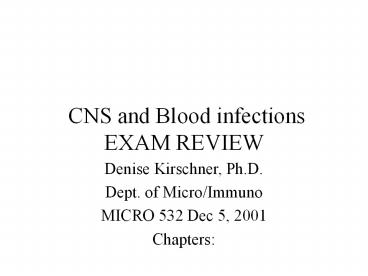CNS and Blood infections EXAM REVIEW PowerPoint PPT Presentation
Title: CNS and Blood infections EXAM REVIEW
1
CNS and Blood infectionsEXAM REVIEW
- Denise Kirschner, Ph.D.
- Dept. of Micro/Immuno
- MICRO 532 Dec 5, 2001
- Chapters
2
Outline
- Central nervous system (CNS) infections
- Meningitis
- Caused by 4 major bacterial species
- Leprosy
- Mycobacterium leprae
- Blood infections
- Plague
- Malaria (protozoan- Plasmodium sp. )
- Subacute bacterial endocarditis (SBE) (Reminder)
- Septicemia (bacteremia)
3
No indigenous microflora
4
Outline
- Central nervous system (CNS) infections
- Meningitis
- Caused by 4 major bacterial species
- Neisseria meningitidis
- Steptococcus pneumoniae
- Haemophilus influenzae
- Listeria monocytogenes
- Leprosy
- Mycobacterium leprae
5
Meningococcal Meningitis-
- cerebrospinal fluid around nervous tissue causes
swelling and brain damage- rapidly fatal, treat
immediately - Headache, fever, stiffness in neck or back
- Causitive agents
- Neisseria meningitidis (children)
- Steptococcus pneumoniae (adults)
- Haemophilus influenzae (children)
- Listeria monocytogenes (older individuals)
6
Microbiology
- Neisseria meningitidis- Toxin mediated (reduces
blood pressure leading to shock). Can cause death
in hours. Attached to mucus membranes via pili,
then into blood and then CSF. Vaccine to capsule.
Speed of treatment is essential. - Steptococcus pneumoniae- can cause middle ear
infections, sinusitis and pneumonia, which occurs
before meningitis. - Haemophilus influenzae First conjugate vaccine.
Introduced in 1987, dramatic decrease of Hib
meningitis. (95 reduction in kids under 5). - Listeria monocytogenes- in adults over 50.
Intracellular pathogen uses comet movement
7
(No Transcript)
8
Streptococcus pneumoniae in cerebral spinal fluid
9
Mycobacterium leprae
- Leprosy invades small nerves of the skin and
then spreads - Only microorganism that infects peripheral nerves
- Grows very slowly (12 day generation time)
- Can be controlled with rifampicin isolation
- Grows well in macrophages, DTH response
10
No indigenous microflora
11
Outline
- Blood infections
- Plague
- Malaria (protozoan- Plasmodium sp. )
- Septicemia (bacteremia)
- Subacute bacterial endocarditis (SBE)
12
Yesinia pestis- PLAGUE
- Black death of the middle ages
- Y. pestis G-, motile rod
- Zoonotic flea, rodent, humans opportunisitc
- Bubonic, pneumonic and septicemic forms
- Tender lymph nodes and cough
- Very fatal
- Treatment with antibiotics can work if early
enough
13
(No Transcript)
14
(No Transcript)
15
(No Transcript)
16
(No Transcript)
17
(No Transcript)
18
Malaria
- Plasmodium species-protozoan
- most virulent Plasmodium falcipirum-
- Vector transmitted- Anopheles mosquito
- Very complex lifecycle
- Drug resistance- to chloroquinine
19
(No Transcript)
20
(No Transcript)
21
Septecemia/Bacteremia
- Blood poisoning
- Violent chills/fever
- G- species (30 ), G, viruses
- Arises from infections in other parts of the body
- Even if treat with antibacterials, very high
mortality
22
(No Transcript)
23
(No Transcript)
24
EXAM REVIEW
25
REVIEW FROM FIRST LECTUREObligate steps for
infectious microbes
- Exposure
- Site of Entry/Interaction
- Attachment/Adherence
- Local evasion (innate)
- Multiplication (colonization/infection)
- Invasion (and potential spread) not all
- Immune Evasion (adaptive)
- Shedding from body to next host (transmission)
- MAIN goal of microbes
26
Review from second lecture Microbial Strategies
- Indigenous microflora
- Evade/Inhibit Phagocytosis
- Induce Tolerance
- Immunosuppression
- Hide or undergo antigenic/phase variation
- Induce the wrong immune response
- Produce toxigenic factors
- -Two outcomes Persistence and latency
27
Review of third lecture U/L Respiratory
Infections
- URT diseases
- Strep Throat
- Diptheria
- Otis Media and Sinusitis and Conjunctivitis
- LRT diseases
- Bacterial pnuemonias
- Whooping cough
- Legionaires Disease
- TB (see next lecture)
28
Review of 4th lecture
- Microbiology of M. tuberculosis
- History and Epidemiology
- Immunobiology and Disease
- Testing and Vaccination
- Therapy chemoprophylaxis and treatment
- Drug Resistance
- Host susceptibility
29
Review from 5th lecture
- Skin Infections
- Contrasting Staph aureus with Strep pyogenes
- Folliculitis, boils and carbuncles (and SBE)
- Rocky mountain spotted fever (R. rickettsii)
- Lyme disease (B. burgdorferi)
- Anthrax (Bacillus anthracis)
- Bacterial infections of Wounds
- Tetanus (C. tetani)
- Gangrene (C. perfringens)
- Burn infections (P. auerginosa)
- Actinomycosis (A. israelii)
30
Review from 6th Lecture
- Epidemiological principles of STDs
- UTI/Bladder infections
- Infections of mucosal surfaces
- Neisseria gonorrhea and Chlamydia trachomatis
- Ulcerative Infections
- Syphilis (T. pallidium) and Chancroid (H. ducreyi)
31
Review from 7th lecture
- Physiology and IM
- Upper Alimentary Tract (UAT) Infections
- Dental pathogens
- H. pylori
- Lower Alimentary Tract (LAT) Infections
- Cholera (V. cholerae)
- Dysentery or Shigellosis (Shigella sp.)
- Gastroenteritis, food poisoning and salmonellosis
- Salmonella (S. cholerasuis and S. typhumurium)
- Travelers Disease (E. coli)
- Typhoid fever (Salmonella typhi)
- Diarrhea (Campylobacter jejuni)
- Non-Salmonella food poisoning- botulism
32
Todays review
- Central nervous system (CNS) infections
- Meningitis
- Caused by 4 major bacterial species
- Leprosy
- Mycobacterium leprae
- Blood infections
- Plague
- Malaria (protozoan- Plasmodium sp. )
- Subacute bacterial endocarditis (SBE) (Reminder)
- Septicemia (bacteremia)

